Rudy Rucker's Blog, page 32
March 29, 2014
My Top Twelve Links
The talented and wonderful people at my web hosting site, www.monkeybrains.net, have a Webalyzer service running that lets me look at the numbers of hits and visits that arrive at the various pages that I maintain on the web—mostly blog posts, but with a few book-title-specific pages as well.
And today I thought I’d run a list of my top twelve most popular links, in descending order of popularity. During the month of March, 2014, so far, these twelve top links have garnered traffic ranging from 140 thousand visits for the top link down to a thousand visits for the twelfth link, with the middle-ranking links in the 10 thousand visits range.
[image error]
For some unknown reason, the image shown above is my most popular. It’s my painting “Fractal Skate Posse,” from 2010, and it’s in the collection of my awesome ski/skate/surf-photographer nephew Embry Rucker III.
And now we’ll move into the list. It would be logical if I illustrated each link with an image from the linked-to page. But fun trumps logic. And I have a backlog of new and old photos here. So, as I so often do, I’m going to illustrate this post with completely random unrelated photos having no obvious connection with the links.
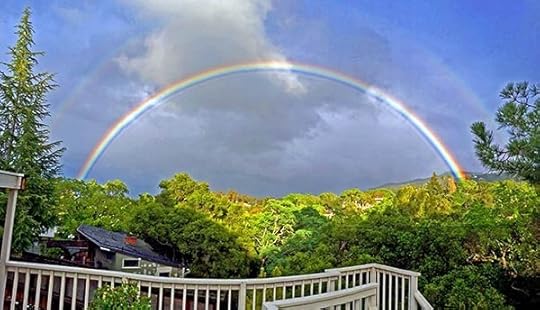
[Amazing rainbow spotted off our porch this week.]
(1) “Anselm Hollo 1934-2013”
This is the link that gets over 140 thousand visits a month. No idea why. It’s a fond reminiscence of my dear departed Finnish-born poet friend, Anselm Hollo, with excerpts of a couple of his wonderful poems.

[I like the cryptic signs on phone poles.]
(2) “In Her Room. My BETTER WORLDS Art Book.”
This one features my online art book about my paintings.

[An Alice In Wonderland style talking flower seen in Oxford where Lewis Carrol taught.]
(3) “The Free PDF Version of Rucker’s SOFTWARE ENGINEERING AND COMPUTER GAMES”
I’m guessing that people in Eastern Europe, Asia, and the Third World are using this page, which features a complete PDF of a computer science textbook that I wrote about programming videogames. I doubt if anyone is using the particular game framework that I designed, but the book has some good info about other software engineering and programming topics as well.
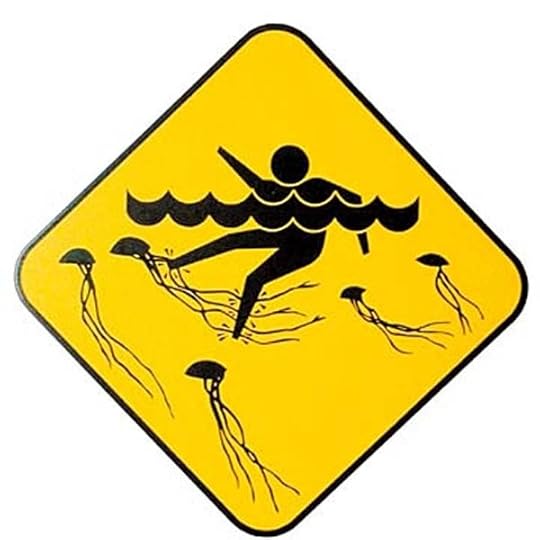
[ Jellyfish warning glyphs. Dig the pain zigzags coming off the distressed stickperson’s legs. And the jellies are like brains with dangling spines.]
(4) “The Free CC Version of Rucker’s WARE TETRALOGY”
I’m really glad that I released the WARE TETRALOGY as a free CC book. It sells fine as a commercial ebook anyway. But having it be free means that it’s in some sense immortal. People will always be able to find it. And it’s fitting to have my core cyberpunk series be out there on the web on its own.

[Always good to see a snake. Sinuous.]
(5) “COMPLETE STORIES by Rudy Rucker, as a Free Webpage”
Easy to see why this link is popular, as it’s a giant web page with all of short stories on it. As with the Ware novels, I do releases like this to keep my work alive.

[A 1930s junker car in a guy’s yard in Pinedale, Wyoming. Crumb’s Mr. Natural had a car like this.]
I love shooting photos in NYC. So much to see.

[ Puddles on our porch. Hail, nature, perfect in every part!]
Learning to see chaos in the natural world is a valuable skill. It makes life more interesting.

[Really dig the new lamps in our library. And the high window of sky. ]
(8) “Golden Gate Bridge, Futurism, & the SF Biz”
Spending a night near the GG bridge, on the Marin side of the bay. I was a paid speaker at a futurism con. Great gig.

[Another spot I’ve photographed many times. Always trying to see it new. Carrying a camera helps. It’s like I get into a conversation with the camera. “You see that?” ]
(9) “The Lick Observatory on Mt. Hamilton”
The Lick is an amazing, other-worldly spot near San Jose, definitely worth a visit. But no way would I ever ride my bicycle up there, as people nowadays like to do.

[Love the annual Jiffy Mart freestyle bicycle-flippers at the Los Gatos Xmas parade. So anachronsitically unsafe.]
(10) “Dave Eggers, THE CIRCLE. Gengen SF.”
The Eggers novel strikes me as an important event relative to our understanding of what the web is doing to our heads. I use the word “gengen” to refer to the ever-increasing wave of SF-genre books which are successfully marketed as general audience books.

[Get a wideangle lens, turn it at an angle, and a home becomes a weightless space station!]
I love the alien-worlds, zero-gravity sensations of scuba diving. Getting almost too old to do it anymore. My records thus far.
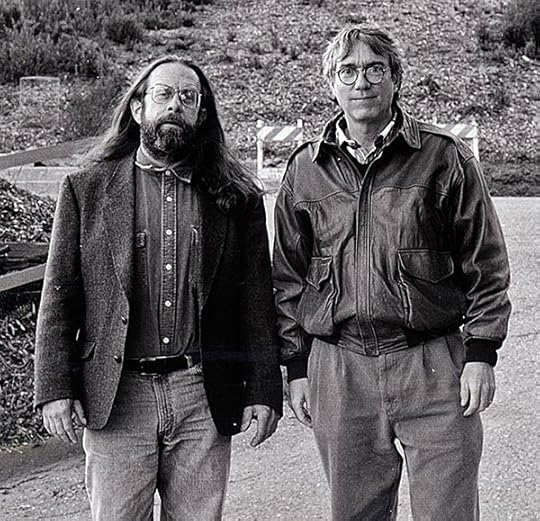
[ Greg Gibson and me near Los Gatos, at the time I was starting to write my novel SAUCER WISDOM. Greg is in the persona of my UFO-abductee character Frank Shook.]
(12) “Four Dimensional Portals To Other Worlds”
I’m forever seeking a magic door to another world. That’s why I write SF.
March 24, 2014
Free BIG AHA Paperbacks at Scribd Reading
A talk, reading, and Q&A about writing and about The Big Aha , a cyberdelic novel which Rudy funded with a Kickstarter campaign.
“Rudy Rucker’s latest novel, The Big Aha, is pure transreal Ruckeriana featuring extreme biological and quantum technologies, steamy techno-sex, nasty aliens from higher dimensions — and all soaked in the unique atmosphere of the magical 1960s. … This is a great example of how science fiction publishing is being redefined.” — Giulio Prisco, io9
.

When? Date: Thursday, March 27. Doors open at 5:30 PM. Event begins at 6. Runs till about 7.
Goodies: Free coffee, tea, wine, non-alcoholic beverages and snacks
Plus free copies of The Big Aha in paperback for the first 30 guests or so.
Get more info and register to attend via Eventbrite.

“The Big Aha gloriously and objectively exists on an absolute level with all of Rucker’s classic work, chockfull of crazy yet scientifically rigorous ideas embodied in gonzo characters and plots. Like a jazzman, Rucker takes his intellectual obsessions as chords and juggles them into fascinating new patterns each time out…a rollercoaster ride that is never predictable and always entertaining…straight out of some Kerouac or Kesey novel, yet with a twenty-first century affect. Rucker is remarkably attuned to a new generation. Ultimately, all the craziness and whimsy and otherworldly menaces of Zad’s mad odyssey induces true pathos and catharsis in the reader.” — Paul Di Filippo, Locus Online.
Where? At the Scribd space, 539 Bryant St. , Suite 200, near Bryant & Second, near South Park.
What is Scribd? As I understand it, Scribd has always been an ebook-sharing site where pretty much anyone can upload any non-pirated text. Recently they’ve been putting more focus on selling commercial ebooks and, even more than that, they’re starting a subscription service that’s something like the Netflix model. For $8.99 a month you can read any ebook that’s distributed via Scribd.

I’m not sure whether or not Scribd’s business model will take wings and fly, but it’s worth a look. They’re offering passwords for free two-month trials, and they have a bunch of my books on their site right now. And, as I mentioned, Scribd is paying for thirty BIG AHA copies to give out at this event, which is pretty great.
Hope to see you there.
March 21, 2014
Living Petroglyphs?
I just finished a new painting, “Hawaii.” It has three big plants and three petroglyphs, although the guy on the right is perhaps morphing into something more.

“Hawaii” oil on canvas, March, 2014, 40” x 30”. Click for a larger version of the painting.
This painting has to do with an experience I had about seven years ago, and which I’m currently trying to fashion into an SF story. For the rest of this post, I’ll just edit some of the relevant passages from my 1997 journals. And, following my usual fashion, the photos will have nothing to do with the subject matter at all.

[Photo taken from the air near Salt Lake City in winter. I call this one, “A New Map of the World.”]
So in August, 1997, my wife Sylvia and I spent a few days at a somewhat generic resort hotel on the big island of Hawaii. The place was called something like the Royal Wak. With its parking-lots, golf-club, and shops, it formed a asphalt island atop a desert of black a’a lava stones.
Among the local sights in Hawaii are the petroglyph markings.

[Paul Mavrides with his black velvet painting of the Challenger disaster.]
Stones bearing petroglyphs are viewed as sacred, but I noticed that the Royal Wak hotel developers had broken up some of them to decorate the little shops around the hotel. Sad broken glyph frags sitting in, like, the flower bed of a Benetton, with educational labels by the glyphs.
I was cuprous about petroglyphs, and I found a little book that talked the glyphs being in places where there is a lot of power, or mana. One big spot is in a lava field near the volcano Mauna Loa. Another was near out hotel, a spot called Puako.

[Greyhound Rock, north of Santa Cruz, CA.]
We went and saw the Puako petroglyphs two times. They’re in a field of smooth pahoehoe lava, which has cracks, making a background pattern like the plates of a turtle shell. The petroglyphs show men, animals, spirits. Many of them are drawn with their heads towards Mauna Kea, the highest peak on the island.
It’s hypothesized that the men etched onto the rock are perhaps projections of the artists, like shadows. I imagined the early Hawaiians of 1300 AD jumping up in the air, looking at their shadows, then drawing that kind of design.
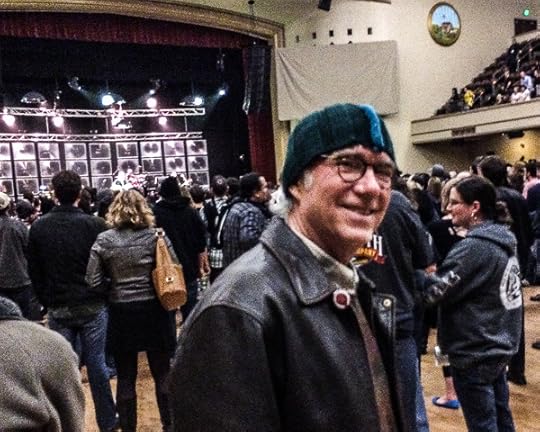
[Rudy at a Pixies concert in San Jose, February, 2014. Hat knit by Georgia Rucker.]
The Puako petroglyph field is in a spooky place, overgrown with introduced exotic kiawe or mesquite thorn trees. In the old days, it was blank lava here, like the slopes of Mauna Loa. So much mana there that it’s a little scary.
There was a menacing warning note at the bottom of the sign at the petroglyph field: “Those who defile or mistreat the petroglyphs must bear the emotional, physical and spiritual consequences for those and those around them—we can take no responsibility for these effects.”
Somewhat foolishly ignoring this, I walked onto the petroglyphs with my shoes off—in my socks—to get a better photo. Immediately I felt like I was trespassing, that I had intruded.

[Anxious tourist, who appeared in an early draft of the “Hawaii” painting. Sylvia’s advice on this detail: “One word, Rudy. Palette-knife.” But I documented him before I scraped him off. He reminds me a little Bill Burroughs in the Amazon jungle, or rather, of a fellow-traveler whom Bill would have made fun of.]
A bit later, dizzy from the August sun, we lost our way and forked off onto a false path in the woods. The criss-crossing shadows of the kiawe branches seemed petroglyph men all over the ground, twisting at odd extra-dimensional angles like A Square coming up out of Flatland, and threatening, nay pursuing me, intent on extracting a terrible vengeance for my defilement of their field.
Back in the room, I heard a knock on my hotel-room door. I peered out through the peephole. A petroglyph is in the hallway—an intense stick-figure of a man, like figure made of glowing fluorescent-light tubes. I didn’t open the door.
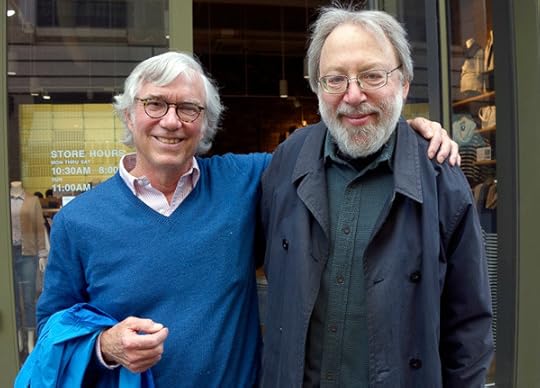
[Rudy with old college room mate Kenneth Turan, now the famed film critic of L.A. Times and NPR. Great to see him up in San Jose this month.]
I did a two-tank scuba beach dive near Puako the next morning. It was good. There was an eel garden at a drop-off to the continental shelf. There were about a hundred eels, silvery green, each with its tail tucked into the smooth white sand, and its body floating erect, wobbling this way and that. A few eels were swimming around free, adjusting their position. They had long slit mouths partly open. Behind them was a huge, huge form slowly moving, a leviathan of the deeps. An extraterrestrial
I felt a sense of mystery, of vastness, a sense enhanced by incipient nitrogen narcosis. The guide and taken me a little too deep.
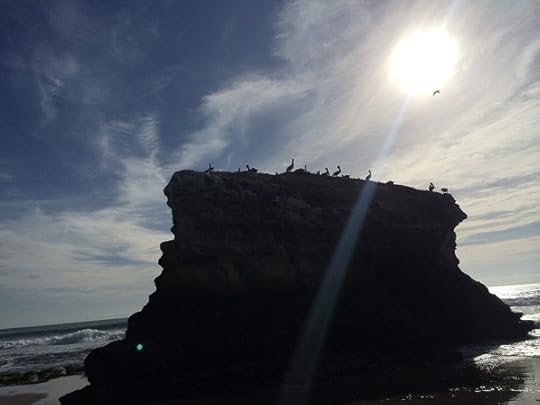
[Natural Bridges in Santa Cruz.]
After the dives I talked to my guide about the petroglyph who was stalking me. He asked, “Is it all the petroglyphs that are after you, or just one of them in particular? Maybe you can get a second petroglyph to help you deal with the first one. Maybe the first one was from a burial site. And the helper-petroglyph might be a turtle.”
“Where would I find a turtle petroglyph to help me?”
“There’s a lot of petroglyphs by the good fishing spots. Meet me this evening and I’ll show you. I go spearfishing near hear at night. The fish are asleep and you can dive and just pick them up. It’s like a supermarket.”
And then? Wait for the finished story…if I manage to write it.

[“Grandpa’s Birthday,” oil, 24 " x 20 ", March, 2013. Note 67 candles, some on cake, some on strawberries.]
And, by the way, tomorrow, March 22, 2014, is my 68th birthday! I’m happy to have made it this far. It’s been interesting the whole way.
March 16, 2014
Spring in California
So, yeah, I enjoyed the rain and now it’s spring.

Love this bank with the exposed root. All the unknown underlying aspects of the world.

Went out to the beach one foggy morn with daughter Georgia, her husband, and their two darling children. The piles of washed up kelp amaze me, so beautifully crafted, for free, discarded, Nature’s bounty.

Awesome heap of seals beside the Santa Cruz dock these days. They wriggle over each other, and “nobody” gets that worked up. Some barking for show, some teeth-baring, but very rarely an actual bite.

Gotta dig that neon Stagnaro’s fish sign. Certain things belong in neon, and one of them is the icon of a fish.
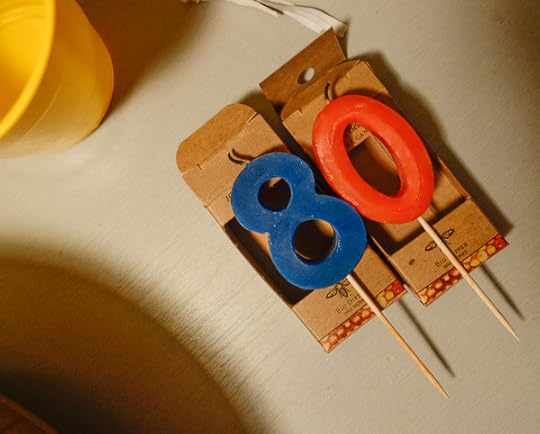
My neighbor Gunnar turned eighty last week and one of the other neighbors gave him a party.
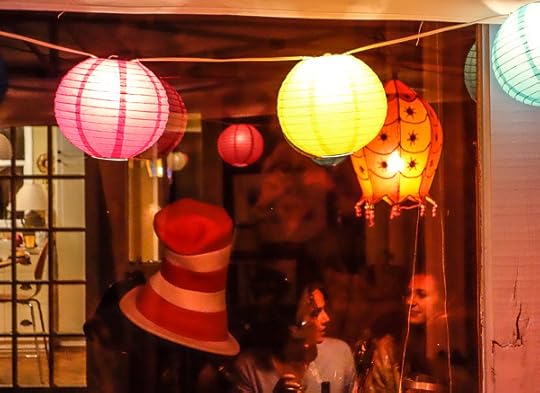
Exciting to go over before hand and see the colored lanterns, and then it was dark and the lanterns were in full play. Party lights.

Markings on cracked asphalt are always an easy photo. Add in a bird and you’re got a composition.

We saw a newt up on a Los Gatos hill, not sure if s/he had slept in this hole or was just hiding in it. Newts, the way they wriggle, always remind me of the way Deadheads dance, repetitively raising the arms and legs.
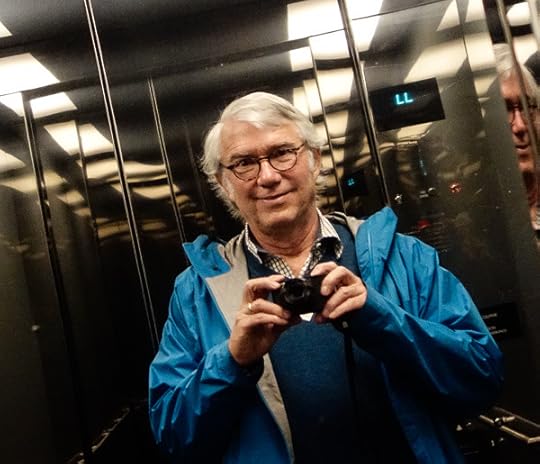
As for me, I’ve been working on some Transreal Books productions, preparing some of my backlist books for re-release. Editing, proofing, designing. I’ll talk more about this in a few weeks when I launch a new Kickstarter to fund the new editions.

I’ve got a birthday of my own coming up, and I can only hope to emulate the example of the eighty-year-old Gunnar, shown here getting funky and way way down.
March 3, 2014
Spring Clearance Sale on my Paintings
It’s time for another sale on my paintings.
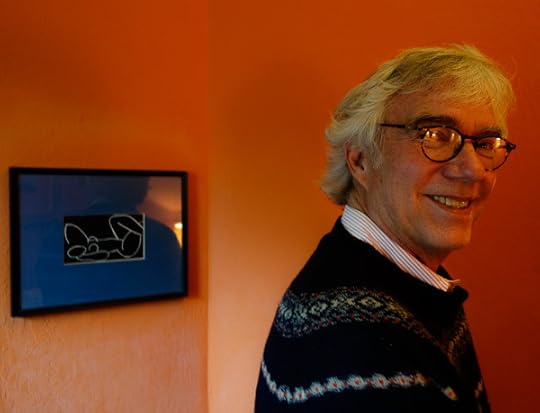
I have no room left in my storage racks, and I’m painting more than ever. Please buy one! I’ve cut just about all the prices by $100 or $200. Check out the prices now. I know some of you said you’d like to buy Frog Man, so here’s your chance!
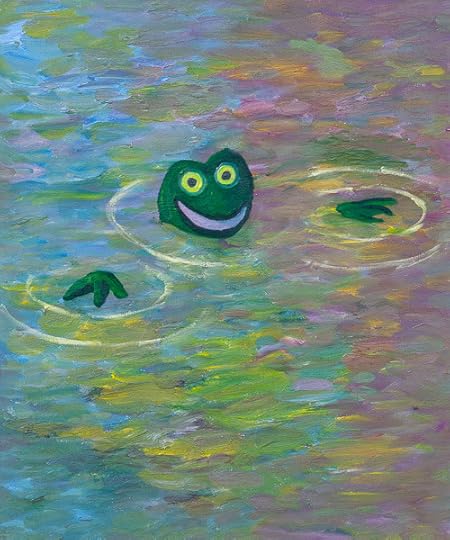
“Frog Man,” oil on canvas, January, 2014, 20” x 24”. Click for a larger version of the painting.
I finished a new painting last week (shown below). The way this one came about is that I was finished writing an SF story “Laser Shades” for a very cool art book, The Superlative Light, by the photographer Robert Shults. The book consists of photos taken in a very-high-power laser lab.

“Laser Shades,” oil on canvas, February, 2014, 24” x 20”. Click for a larger version of the painting.
While I was working on the story, I wasn’t quite sure about how to end it, and then I made my new painting as a way of previsualizing a big scene. The guy in the painting is wearing special laser-proof shades and he’s (rather unwisely) holding a fetal “egg” in the path of a yottawatt laser beam. A yottawatt is about the power of the Sun. That zapped egg is going to hatch out some kind of weird person, so look out!
Eventually I’ll post the story online, but not yet. I’ll let Shults’s book come out first. Also I might read the story somewhere this spring, and if I do, I’ll put up a podcast of the reading.

I was up at Borderlands Books on Valencia Street in SF yesterday to see my old friend and way-gnarly SF writer Dr. Michael Blumlein doing a presentation on his new book of stories, What the Doctor Ordered. It was a good show. Learn more about the book on Michael’s home page.
Speaking of Borderlands, my Big Aha show of paintings there has been extended until March 29, 2014. So if you’re a local, you can check out some of my latest paintings in person. And then buy one!
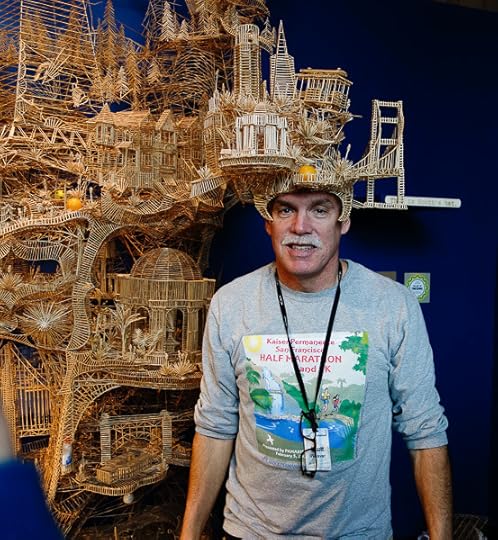
And speaking of art projects, Sylvia and I saw this man Scott Weaver doing a demo at The Exploratorium in San Francisco early in February. His life’s work is a giant toothpick sculpture, kind of depicting San Francisco as a whole. He’s been tinkering with it for thirty-five years Weaver also has a toothpick hat that he sometimes wears while discussing his work.
March 1, 2014
Dave Eggers, THE CIRCLE. “Gengen SF.”
I just read the new Dave Eggers book, The Circle . It started out a little slow, but then it became a page-turner. I plowed through it in two days, thinking a lot about the characters and the ideas, and when it was done, I missed having it to read.
I liked the book a lot. It got to me.
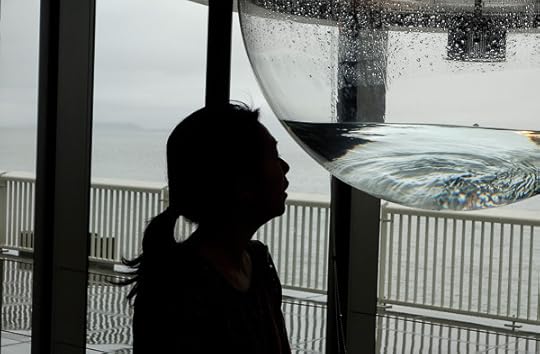
The “Circle” is a company something like Google + Twitter + Facebook. They’re working to take over the world, ultimately controlling all information and all elections, and making it impossible (and illegal) for anyone to be offline. The main character is Mae Holland. She starts out as something of a free spirit, but she’s also ambitious, a striver, and very much a people pleaser. And by the end, she’s a self-deluding and heartless zealot. You empathize with her, pity her, and end by despising her—which is just what you’re supposed to do. The book is something of a moral fable.
Being a science fiction writer, I’m interested in the fact that The Circle is a science fiction novel by a mainstream writer, and it’s being marketed as a general audience book. Not that these general audience books use the “SF” genre label. They’re “visionary,” “speculative,” “dystopic,” “novels of the near future,” and so on.
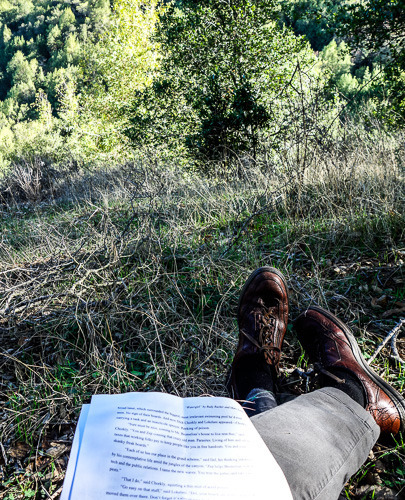
[Happy moment for a writer. Sitting on a hillside with a manuscript to correct.]
I’d been wondering what exactly to call these books. I don’t necessarily want a bitter, negative word for them…I don’t want to be like a crusty old-time Mission hipster throwing rocks at a Google bus. So I posed the what-do-you-call-these-books question on Facebook, and a person with the screen name “Post Script” coined what I think a the perfect word. Gengen.
Gengen is a cozy word, pleasant to say, and this is important for a new coinage. I see the gengen move as working in two directions. The name can be read either as “general audience genre” book, or “genre book that’s broken out to a general audience.” It isn’t inherently disparaging to either side. You can be an SF writer moving onto the general shelves, as William Gibson has done and as Kurt Vonnegut did before him.. Or you can be a denizen of the general shelves, safe in your position, wanting to get wild and write a genre book—like Margaret Atwood, Gary Shteyngart, Jonathan Lethem, Chang-Rae Lee, and nnow Dave Eggers.
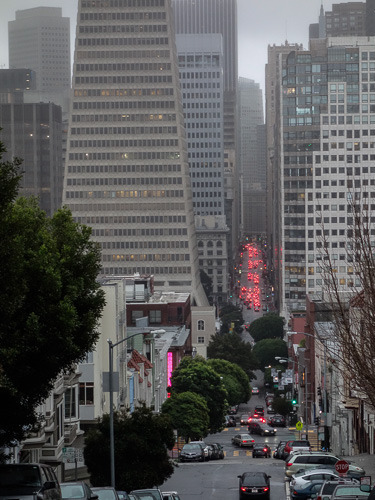
(By the way, re. “gengen,” someone might protest that there are other genres besides SF. That’s fine, and if someone wants to have a gengen discussion about the detective or romance or western genres, sure, why not. Gengen is a type of move, a sidling between the genre ghetto and the shopping street. But it’s gengen SF that I’m talking about in this post, and often as not I’ll just call them gengen for short.)
There’s more and more gengen books these days—the SF mode has acquired a trendiness, a cachet. And really that’s good. I like reading SF books, and if they’re gengen by a talented writer, so much the better.

[View from the poetry room in City Lights Books.]
Of course, some pro SF writers might jeer, “The Brahmins are wading in the funky Ganges where we hardcore SF sadhus have wallowed for, lo, these many years.” Or, “Are we lowly science-fiction pros expected to be grateful when a mainstream writer stoops to filch a bespattered icon from our filthy wattle huts?” Not, harrumph, that I would ever say those kinds of things. Yes, I do write literary SF, and I don’t get much recognition in the general market, but I don’t want to be all bitter and resentful about this, at least not all the time. Today I want to talk about gengen and about Eggers’s excellent The Circle.
In discussing gengen, critics often namecheck Orwell’s 1984 and Huxley’s Brave New World. And there’s much of Brave New World in The Circle.
Mae and her Circle bosses formulate three sayings that could have been lifted directly from 1984: “A Secret is a Lie.” “Sharing Is Caring.” “Privacy Is Theft.”
The Circle does lack certain things—I’m thinking of cyberpunk flash, wild SFnal speculations, and rollicking laugh-out-loud humor. But that’s not what Eggers was trying to do, so there’s no point bugging him about it. The Circle totally nails the points that he wanted to hit. Like the pious holier-than-thou and insanely-naive attitude of techies who want to run everyone’s lives and have everyone be so much better and cleaner than humans are meant to be. They even use that old line, “Why would you want privacy unless you have something you want to hide?” And there’s a cutting riff on the self-aggrandizement of a cubicle-dweller who feels brave because she “liked” someone’s strongly political post. And Eggers really gets the brutal, brutal work schedule of computer types.

My mind was blown by a couple of scenes where Mae goes into zombie-mode feeding-frenzy bloodlust-clicking-frenzy and spends hours or even a whole night working the social sites, building up her rankings, raising her various virtual scores, all of these scores being precise numbers you understand—Eggers goes ape on this, and has a one-or-two-page paragraph where every clause contains a number that Mae is pumping for better job security and higher self esteem.
And reading those scenes, I was repelled, but also, I had to think, “My god, this is me. I do this.” Obsessively spinning from Twitter to Facebook to email to my iPhone messages to the work on my new blog post to the latest tweaks of the HTML on my umpteen webpages, then back to Twitter to Facebook to… I’ve spent whole days like this, lost in the clicks, returning to each site over and over, hungry for comments, for Likes, for reviews, for response…
I think of a pigpen that my friends and I used to enjoy visiting at the Rutgers Agricultural School campus, back when I was in grad school at Rutgers in 1970, a tidy pen, with a feeding-trough at the near end, and a hinged metal flap over the trough, and every so often a pig would come to the trough and nose up the flap, the younger ones did this more often, and usually there wouldn’t be anything in the trough, and the lid would click on the way up and then clank back down. No mail. No comments. No likes. Click clank. Or maybe there’s one left-over nugget of chow. Great streamers of saliva. Possibly an exultant squeal.

Another thing in The Circle that got to me was that Mae starts out with a pantheistic or nature-worshipping side to her. She likes to kayak out into the San Francisco Bay, enjoying the company of the watchful seals, loving the light on the water, even exploring a deserted little island by night, wholly in the now, fully analog, not even thinking of checking her phone.
That’s when I loved Mae the most, when she was doing these kinds of things that I myself place great value on, getting outside and into nature, and leaving all the computer crap behind. I’m sure Eggers himself has this side to him, or he wouldn’t have been able to evoke it so movingly. And then—what a bummer—the Circle bureaucrats kind of crush Mae for going offline like this. And from here on in her personality is pretty much destroyed. She loses her contact with the natural world—and she loses her soul. Echoing Winston Smith in 1984.
So yeah, The Circle is a great book. Viva gengen.
See the Facebook comments on this post.
See the Facebook comments on the "gengen" word .
Dave Eggers, THE CIRCLE. “Gengen SF.” Laser Shades Painting.
I just read the new Dave Eggers book, The Circle . It started out a little slow, but then it became a page-turner. I plowed through it in two days, thinking a lot about the characters and the ideas, and when it was done, I missed having it to read.
I liked the book a lot. It got to me.

The “Circle” is a company something like Google + Twitter + Facebook. They’re working to take over the world, ultimately controlling all information and all elections, and making it impossible (and illegal) for anyone to be offline. The main character is Mae Holland. She starts out as something of a free spirit, but she’s also ambitious, a striver, and very much a people pleaser. And by the end, she’s a self-deluding and heartless zealot. You empathize with her, pity her, and end by despising her—which is just what you’re supposed to do. The book is something of a moral fable.
Being a science fiction writer, I’m interested in the fact that The Circle is a science fiction novel by a mainstream writer, and it’s being marketed as a general audience book. Not that these general audience books use the “SF” genre label. They’re “visionary,” “speculative,” “dystopic,” “novels of the near future,” and so on.

[Happy moment for a writer. Sitting on a hillside with a manuscript to correct.]
I’d been wondering what exactly to call these books. I don’t necessarily want a bitter, negative word for them…I don’t want to be like a crusty old-time Mission hipster throwing rocks at a Google bus. So I posed the what-do-you-call-these-books question on Facebook, and a person with the screen name “Post Script” coined what I think a the perfect word. Gengen.
Gengen is a cozy word, pleasant to say, and this is important for a new coinage. I see the gengen move as working in two directions. The name can be read either as “general audience genre” book, or “genre book that’s broken out to a general audience.” It isn’t inherently disparaging to either side. You can be an SF writer moving onto the general shelves, as William Gibson has done and as Kurt Vonnegut did before him.. Or you can be a denizen of the general shelves, safe in your position, wanting to get wild and write a genre book—like Margaret Atwood, Gary Shteyngart, Jonathan Lethem, Chang-Rae Lee, and nnow Dave Eggers.

(By the way, re. “gengen,” someone might protest that there are other genres besides SF. That’s fine, and if someone wants to have a gengen discussion about the detective or romance or western genres, sure, why not. Gengen is a type of move, a sidling between the genre ghetto and the shopping street. But it’s gengen SF that I’m talking about in this post, and often as not I’ll just call them gengen for short.)
There’s more and more gengen books these days—the SF mode has acquired a trendiness, a cachet. And really that’s good. I like reading SF books, and if they’re gengen by a talented writer, so much the better.

[View from the poetry room in City Lights Books.]
Of course, some pro SF writers might jeer, “The Brahmins are wading in the funky Ganges where we hardcore SF sadhus have wallowed for, lo, these many years.” Or, “Are we lowly science-fiction pros expected to be grateful when a mainstream writer stoops to filch a bespattered icon from our filthy wattle huts?” Not, harrumph, that I would ever say those kinds of things. Yes, I do write literary SF, and I don’t get much recognition in the general market, but I don’t want to be all bitter and resentful about this, at least not all the time. Today I want to talk about gengen and about Eggers’s excellent The Circle.
In discussing gengen, critics often namecheck Orwell’s 1984 and Huxley’s Brave New World. And there’s much of Brave New World in The Circle.
Mae and her Circle bosses formulate three sayings that could have been lifted directly from Huxley: “A Secret is a Lie.” “Sharing Is Caring.” “Privacy Is Theft.”
The Circle does lack certain things—I’m thinking of cyberpunk flash, wild SFnal speculations, and rollicking laugh-out-loud humor. But that’s not what Eggers was trying to do, so there’s no point bugging him about it. The Circle totally nails the points that he wanted to hit. Like the pious holier-than-thou and insanely-naive attitude of techies who want to run everyone’s lives and have everyone be so much better and cleaner than humans are meant to be. They even use that old line, “Why would you want privacy unless you have something you want to hide?” And there’s a cutting riff on the self-aggrandizement of a cubicle-dweller who feels brave because she “liked” someone’s strongly political post. And Eggers really gets the brutal, brutal work schedule of computer types.

My mind was blown by a couple of scenes where Mae goes into zombie-mode feeding-frenzy bloodlust-clicking-frenzy and spends hours or even a whole night working the social sites, building up her rankings, raising her various virtual scores, all of these scores being precise numbers you understand—Eggers goes ape on this, and has a one-or-two-page paragraph where every clause contains a number that Mae is pumping for better job security and higher self esteem.
And reading those scenes, I was repelled, but also, I had to think, “My god, this is me. I do this.” Obsessively spinning from Twitter to Facebook to email to my iPhone messages to the work on my new blog post to the latest tweaks of the HTML on my umpteen webpages, then back to Twitter to Facebook to… I’ve spent whole days like this, lost in the clicks, returning to each site over and over, hungry for comments, for Likes, for reviews, for response…
I think of a pigpen that my friends and I used to enjoy visiting at the Rutgers Agricultural School campus, back when I was in grad school at Rutgers in 1970, a tidy pen, with a feeding-trough at the near end, and a hinged metal flap over the trough, and every so often a pig would come to the trough and nose up the flap, the younger ones did this more often, and usually there wouldn’t be anything in the trough, and the lid would click on the way up and then clank back down. No mail. No comments. No likes. Click clank. Or maybe there’s one left-over nugget of chow. Great streamers of saliva. Possibly an exultant squeal.

Another thing in The Circle that got to me was that Mae starts out with a pantheistic or nature-worshipping side to her. She likes to kayak out into the San Francisco Bay, enjoying the company of the watchful seals, loving the light on the water, even exploring a deserted little island by night, wholly in the now, fully analog, not even thinking of checking her phone.
That’s when I loved Mae the most, when she was doing these kinds of things that I myself place great value on, getting outside and into nature, and leaving all the computer crap behind. I’m sure Eggers himself has this side to him, or he wouldn’t have been able to evoke it so movingly. And then—what a bummer—the Circle bureaucrats kind of crush Mae for going offline like this. And from here on in her personality is pretty much destroyed. She loses her contact with the natural world—and she loses her soul.
So yeah, The Circle is a great book. Viva gengen.
And now back to the life of this old SF writer…

“Laser Shades,” oil on canvas, February, 2014, 24” x 20”. Click for a larger version of the painting.
Last week I finished writing my SF story “Laser Shades” for this very cool art book, The Superlative Light, by the photographer Robert Shults.
While I was working on the story, I wasn’t quite sure about how to end it, and then I did this painting as a way of previsualizing a big scene. The guy is wearing special laser-proof shades and he’s (rather unwisely) holding a fetal “egg” in the path of a yottawatt laser beam. A yottawatt is about the power of the Sun. That zapped egg is going to hatch out some kind of weird person, so look out!
Eventually I’ll post the story online, but not yet. I’ll let Shults’s book come out first. Also I might read the story somewhere this spring, maybe at SF in SF.
February 18, 2014
Ripping Vinyl to iTunes
The ripping-vinyl-to-iTunes process has two main stages.
(1) Getting the info off the viny disks and into mp3 files.
(2) Importing the mp3 files into iTunes in a usable form.
Here are the links to my old (but recently revised) posts on this.
(1) “Ripping Vinyl to MP3s for iTunes”
(2) “Managing Music in iTunes”
Taming those wiggly audio wave forms.

By the way, the second post can be useful whether or not you’re in fact ripping from vinyl—it has some good info about making iTunes more transparent and more accessible to your control.
Context?
I just finished writing an SF story called “Laser Shades” for an interesting book project, The Superlative Light, by the photographer Robert Shults. Shults got some good funding for his book, and I think it’ll come out in late 2014 or in 2015. Eventually I’ll post my story where you can see it too.
In any case, I have a little free time just now, so I went back to a kind of obsessive time-wasting project that I was into back in 2011: ripping some of my old vinyl records to MP3 files that I can load into iTunes and copy to my smart phone.
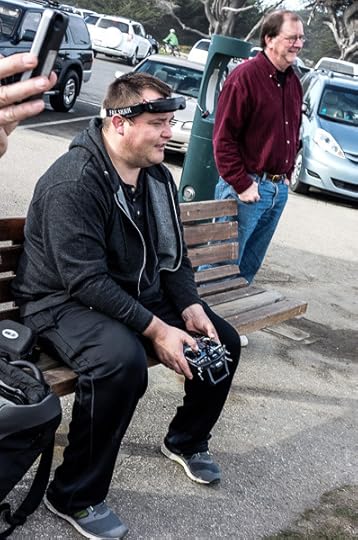
[A happy hacker using VR goggles to guide a little camera-equipped drone helicopter around Steamer’s Lane in Santa Cruz.]
In 2011, I wrote those two blog posts describing how I’m doing this, and I linked to them at the start of today’s post. I’ve found it’s important, when I’m doing something ultrageeky, to write down what I did—because this is the kind of info that I tend to forget in a few months, and certainly in a few years. Learning how to do something intricate on a comptuer is like learning all the part-numbers for a 1975 Ford Galaxie carburetor and memorizing the thing’s little manual. Impossible to retain.

[Just before midnight on New Years Eve in Pinedale, Wyoming! (Lo-res smartphone photo.)]
So I went back and found my two old webpages, and used the info, and upgraded it a little bit. And here, for your own use are the links to those pages. My two prereqs for the software tools I used were
* To find free, reliable, non-malware-type software to do what I needed, and
* To be able to use the software pretty easily.
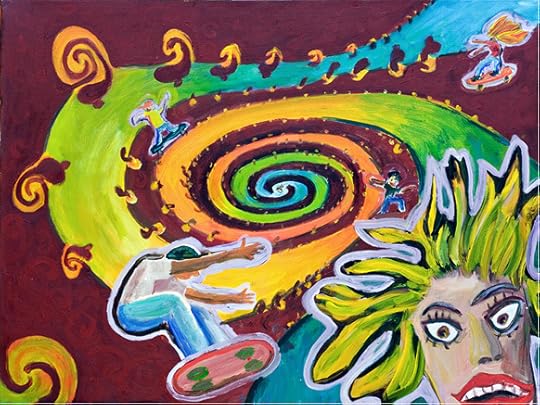
[My 2013 painting “Fractal Skate Posse,” see my paintings page for info, prints and my Jan-March 2014 show at Borderlands in SF.]
I’m a Windows user, so some of the wares I found are in fact available only for Windows. Finding good free software for the Mac OS can in some cases be a little harder, but if you know of some, do put a comment on this page or on the pages I’m directing you to.
One final note on this issue—by “free” software, I don’t mean commercial software that comes with a “free trial” which a crippled, or partly disabled, or money-begging mode—or outright malware! “Free” means solid, programmer-written wares that you find on a reliable programmer-run site like Sourceforge.
So now dig out that crufty old turntable and rescue such massive gems as Ton-Loc’s “Wild Thing,” simple as wallpaper but somehow quite wonderful.
February 8, 2014
“All the Visions” Painting. Our Yottawatt Sun.

I just finished another painting this week, All the Visions.

“All the Visions,” oil on canvas, February, 2014, 24” x 20”. Click for a larger version of the painting.
The painting is based on a photo taken in 1983, I think I used the timer on my camera and shot it myself. Possibly my photographer friend David Abrams shot it. But I’m guessing that I shot it, as I have the color print.
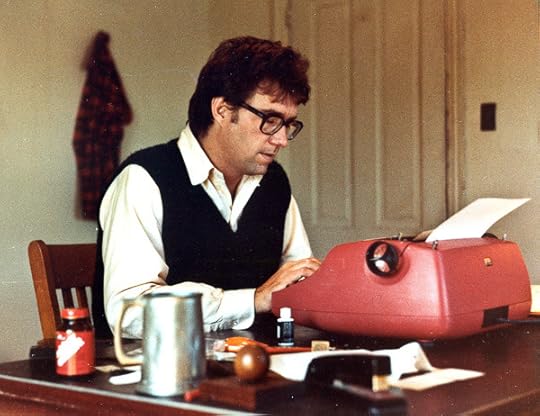
This has to do with a Kerouac-style novel called All The Visions that I wrote on a single long scroll of paper that year in Lynchburg, Virginia. (The photo shows a warm-up session when I wasn’t yet using the scroll). You can’t see the UFO in the photo, but it’s clear in the painting. I plan to reissue All The Visions via Transreal Books later in 2014 — it appeared from a small press, Ocean View Books, in 1991. I still have that rose red IBM Selectric typewriter in my basement. The acme of modern writing equipment in 1983. I wrote a lot of books on that thing.

Otherwise I’m just hanging out, doing some work on a revision of All the Visions, also starting up on an SF story having to do with an extremely powerful laser. I’m thinking its power is at the yottawatt level.
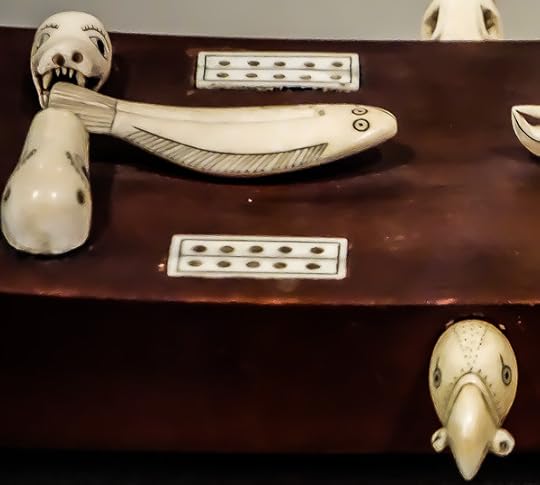
I like these sequences of power prefixes, Kilowatt —> Megawatt —> Petawatt —> Exawatt —> Zettawatt —> Yottawatt. There’s a Wikipedia page explaining it.
[image error]
Our Sun’s luminosity is 385 yottawatts. But we don’t get the full benefit of all this light. Earth gets a steady illumination of about 174 petawatts from the Sun. How much does sunlight cost? How much would it cost to keep the light on? Well, a kilowatt-hour costs 12 cents. Call it 10 cents. Sun gives us about 170 petawatts. So an hour of that is 170 trillion kilowatt hours. So sunlight cost is 12 cents * 170 trillion per hour, which is about 20 trillion dollars per hour. Average that out over 7 billion people. About $3000 dollars per hour per person. Call it two million a month. “The power bill’s here!”

I’m glad that it’s raining today. All this weather for free. And that amazing yottawatt sun driving the whole thing.
February 1, 2014
Gave Two Talks: Dorkbot & Transhuman Visions
I gave two talks this week. Wednesday I was at the Cyclecide Swearhouse in San Francisco, reading from The Big Aha for a Dorkbot event. I didn’t tape it, but some video may appear on the dorkbot archive page for this event in a week or so.
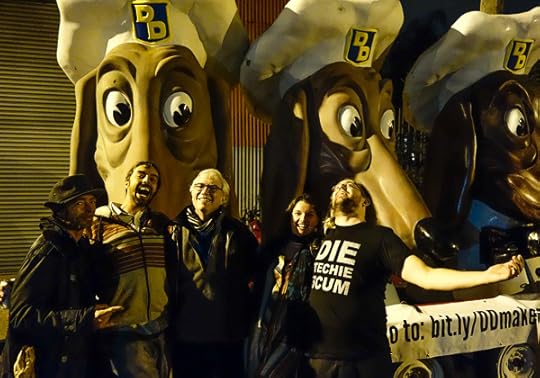
Photo above shows Jericho Reese, Rudy Jr., me, Isabel R., and techie Mark Powell in his anti-tech T-shit. In the background we have John Law’s Doggie Diner icons.

Another picture of Mark Powell…reading a poem “I’m on TV!” Love how fervent he looks. It was a great evening for me, hanging out with the cool Dorkbot crowd.
===
Today I was at the Transhuman Visions conference at Fort Mason in San Francisco and gave a talk called “The Big Aha: Cosmic and Robotic Consciousness.” It went over well, got some big laughs. You can click on the icon below to access the podcast via my Feedburner podcast station.
(Note that Feedburner only shows my most recent podcasts. For older audio files, see my archive on Gigadial, which runs back to 2005.)
And you can view my slides online as a PDF file.
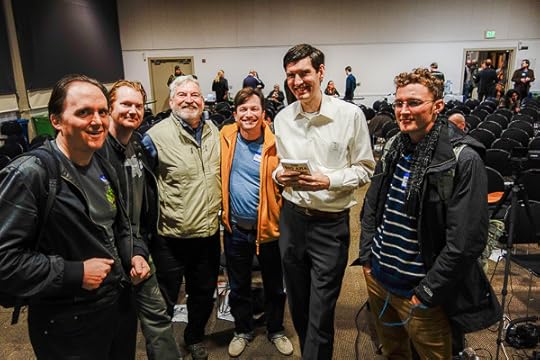
After my Transhuman talk, some nice people talked to me for awhile, and I took a picture of them shown below. Didn’t get all their names but starting second from the left, that’s David Dye, Jr. and Sr., Dan Dye, and a guy called Scott. These four forward-thinking men bought copies of my books.

One other event worth noting. I happened to mention one Frank Shook in my Transhumans talk, and incredibly, I ran into this man soon thereafter, the hero of Saucer Wisdom. Frank has resurfaced in the persona of an antiquarian bookseller Gregory Gibson, running a front organization called Ten Pound Island Books. His cover story was that he was at Fort Mason for the Antiquarian Book Fair.
Frank, who tends to disorder and undermine any and all aspects of consensus reality insisted I was talking about “transhumance,” instead of “transhumans.” And, now that Frank has said this, there is indeed a Wikipedia word “transhumance,” applying to nomadic people. A strange and powerful entity is Mr. Shook. I believe he’s re-manifesting himself because I am making some plans to republish my long-suppressed Saucer Wisdom exposé.
Rudy Rucker's Blog
- Rudy Rucker's profile
- 583 followers





